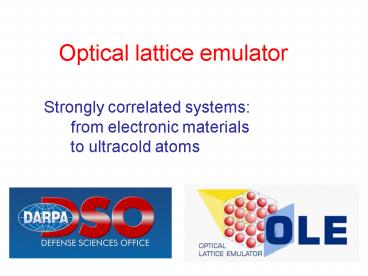Optical lattice emulator PowerPoint PPT Presentation
1 / 25
Title: Optical lattice emulator
1
Optical lattice emulator
Strongly correlated systems from
electronic materials to ultracold atoms
2
Conventional solid state materials
Description in terms of non-interacting
electrons. Band structure and Landau Fermi
liquid theory
Intel 386DX microprocessor
3
Conventional solid state materials
Electron-phonon and electron-electron
interactions are irrelevant at low temperatures
ky
kx
Landau Fermi liquid theory when frequency and
temperature are smaller than EF electron systems
are equivalent to systems of non-interacting
fermions
kF
Ag
Ag
Ag
4
Non Fermi liquid behavior in novel quantum
materials
Violation of the Wiedemann-Franz law in high Tc
superconductors Hill et al., Nature 414711
(2001)
UCu3.5Pd1.5 Andraka, Stewart, PRB 473208 (93)
CeCu2Si2. Steglich et al., Z. Phys. B 103235
(1997)
5
Puzzles of high temperature superconductors
Unusual normal state
Maple, JMMM 17718 (1998)
Resistivity, opical conductivity, Lack of sharply
defined quasiparticles, Signatures of AF, CDW,
and SC fluctuations
Mechanism of Superconductivity
High transition temperature, retardation effect,
isotope effect, role of elecron-electron and
electron-phonon interactions
Competing orders
Role of magnetsim, stripes, possible
fractionalization
6
Applications of quantum materialsHigh Tc
superconductors
7
High temperature superconductors
Superconducting Tc 93 K
Hubbard model minimal model for cuprate
superconductors
P.W. Anderson, cond-mat/0201429
8
Positive U Hubbard model
Possible phase diagram. Scalapino, Phys. Rep.
250329 (1995)
Antiferromagnetic insulator
D-wave superconductor
9
Fermionic atoms in optical lattices
Quantum simulation of the fermionic Hubbard
model using ultracold atoms in optical latices
10
Fermions in a 3d optical lattice, Kohl et al.,
PRL 2005
Superfluidity of fermions in an optical lattice,
Chin et al., Nature 2006
11
Simulation of condensed matter systems Hubbard
Model and high Tc superconductivity
Questions for future work
- What is the ground state of the Hubbard model
away from filling n1
- Beyond plain vanilla Hubbard model
- a) Boson-Fermion mixtures Hubbard model
phonons - b) Inhomogeneous systems (stripes), role of
disorder
- Detection of many-body states
- (spin antiferromagnetisim, d-wave
superconductivity , CDW, )
12
How to detect antiferromagnetic order and d-wave
pairing in optical lattices?
Quantum noise ?!
13
Second order interference from the BCS superfluid
n(k)
k
BCS
BEC
14
Momentum correlations in paired fermions
Greiner et al., PRL 94110401 (2005)
15
Fermion pairing in an optical lattice
Second Order Interference In the TOF images
Normal State
Superfluid State
measures the Cooper pair wavefunction
One can identify unconventional pairing
16
Second order coherence in the insulating state of
bosons and fermions
Theory Altman et al., PRA 7013603 (2004)
Expt Folling et al., Nature (2005) Spielman et
al., PRL (2007) Rom et al., Nature (2006)
Bosonic bunching
Fermionic antibunching
A powerful tool for detecting antiferromagnetic
order
17
Boson Fermion mixtures
Experiments ENS, Florence, JILA, MIT, ETH,
Hamburg, Rice, Duke, Mainz,
Bosons provide cooling for fermions and mediate
interactions. They create non-local attraction
between fermions
Theory Pu, Illuminati, Efremov, Das, Wang,
Matera, Lewenstein, Buchler,
18
Boson Fermion mixtures
Phonons Bogoliubov (phase) mode
Effective fermion-phonon interaction
Fermion-phonon vertex
Similar to electron-phonon systems
19
Bose-Fermi mixture in a three dimensional optical
lattice
Gunter et al,
PRL 96180402 (2006)
See also Ospelkaus et al, PRL 96180403 (2006)
Suppression of superfluidity of bosons by fermions
Similar observation for Bose-Bose mixtures, see
Catani et al., arXiv0706.278
Issue of heating and density rearrangements need
to be sorted out, see e.g. Pollet et al.,
cond-mat/0609604
20
Competing effects of fermions on bosons
Fermions provide screening. Favors superfluid
state of bosons
Orthogonality catastrophy due to fermions.
Polaronic dressing of bosons. Favors Mott
insulating state of bosons
21
Quantum regime of bosons
A better starting point
Mott insulating state of bosons
Free Fermi sea
Theoretical approach generalized Weiss theory
22
Weiss theory of the superfluid to Mott
transition of bosons in an optical lattice
Mean-field a single site in a self-consistent
field
23
Weiss theory quantum action
Conjugate variables
Adding fermions
Screening
Orthogonality catastrophy
24
SF-Mott transition in the presence of fermions
Competition of screening and orthogonality
catastrophy (G. Refael and ED)
Effect of fast fermions tF/U5
Effect of slow fermions tF/U0.7
25
Atoms in optical lattice
Antiferromagnetism and pairing at sub-micro
Kelvin temperatures
Same microscopic model

